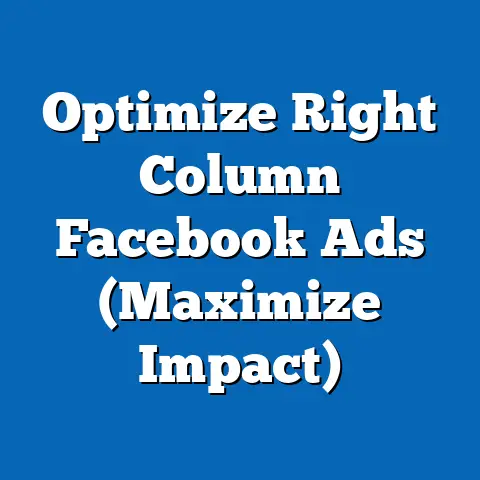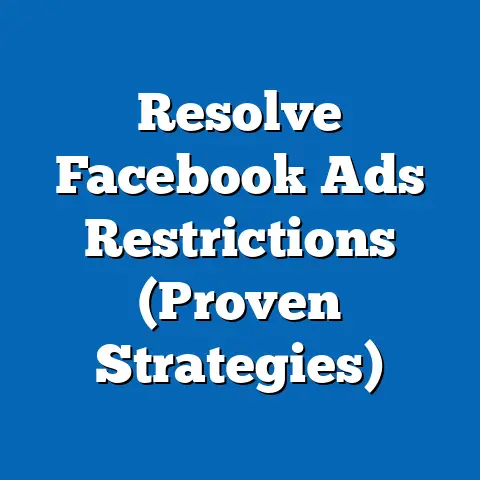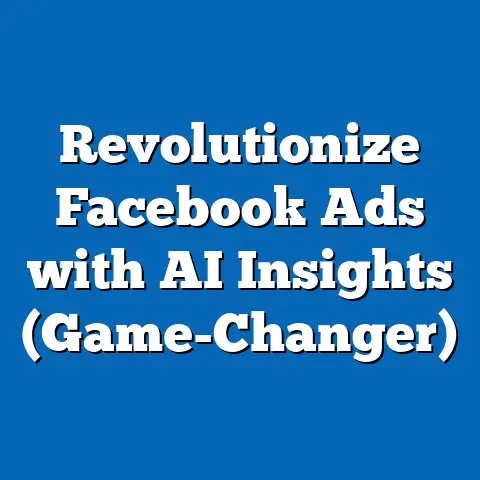Craft Winning Facebook Ads in Minutes (Pro Tips Unveiled)
Did you know that Facebook boasts over 2.9 billion monthly active users as of 2023, making it the largest social media platform globally (Statista, 2023)? This staggering figure translates into an unparalleled opportunity for businesses to reach diverse audiences through targeted advertising. With over 10 million active advertisers on the platform, crafting effective Facebook ads has become a critical skill for marketers aiming to stand out in a crowded digital space (Hootsuite, 2023).
The potential return on investment (ROI) is significant—studies show that for every $1 spent on Facebook ads, businesses can generate an average of $5.20 in revenue (WordStream, 2023). However, success isn’t guaranteed; poorly designed ads can drain budgets without delivering results. This article dives deep into proven strategies and pro tips to create winning Facebook ads in minutes, backed by data, trends, and actionable insights.
Whether you’re a small business owner, a seasoned marketer, or a freelancer, understanding the nuances of Facebook advertising can transform your campaigns. From demographic targeting to creative optimization, we’ll explore every facet of crafting ads that convert. Let’s break down the essentials step by step.
Section 1: Understanding the Facebook Advertising Landscape
1.1 The Scale of Facebook Ads
Facebook’s advertising platform has grown exponentially since its inception in 2007. As of 2023, the platform generates over $114 billion in annual ad revenue, accounting for nearly 25% of the global digital advertising market (eMarketer, 2023). This growth underscores the platform’s dominance and the fierce competition among advertisers.
Businesses of all sizes leverage Facebook ads, with small and medium-sized enterprises (SMEs) making up a significant portion of advertisers—over 70% of the 10 million active advertisers fall into this category (Facebook Business, 2023). This democratization of advertising means that even startups with modest budgets can compete with industry giants if they strategize effectively.
1.2 Key Trends Shaping Facebook Advertising
Several trends are shaping the future of Facebook ads. First, video content continues to dominate engagement, with video ads accounting for 50% of total ad impressions in 2022, a 20% increase from 2019 (Socialbakers, 2022). Additionally, the rise of mobile-first advertising is undeniable—over 94% of Facebook’s ad revenue comes from mobile devices (Statista, 2023).
Another critical trend is the increasing reliance on artificial intelligence (AI) for ad optimization. Facebook’s algorithm, powered by machine learning, prioritizes ads based on user behavior, making it essential for advertisers to align content with audience preferences. Privacy changes, such as Apple’s iOS 14 update in 2021, have also impacted targeting capabilities, with 62% of marketers reporting reduced ad performance due to limited data tracking (Forbes, 2022).
1.3 Demographic Insights for Targeting
Facebook’s user base spans a wide range of demographics, but certain groups are more active than others. According to Pew Research (2022), 70% of U.S. adults aged 18-29 use Facebook, compared to 54% of those aged 50-64. Gender distribution is relatively balanced, with 51% female and 49% male users globally (DataReportal, 2023).
Geographically, the largest user bases are in India (340 million users), the United States (180 million users), and Indonesia (130 million users) as of 2023 (Statista, 2023). Understanding these demographics is crucial for tailoring ad content—younger audiences may respond better to trendy visuals, while older users might prioritize value-driven messaging. These insights lay the foundation for crafting targeted, effective campaigns.
Section 2: Why Speed Matters in Crafting Facebook Ads
2.1 The Need for Agility in Digital Marketing
In today’s fast-paced digital landscape, the ability to create and launch ads quickly can be a game-changer. A 2022 study by HubSpot found that campaigns launched within 48 hours of identifying a trend saw a 30% higher engagement rate compared to delayed campaigns. Speed allows marketers to capitalize on viral moments, seasonal events, or breaking news.
However, speed must not compromise quality. Poorly designed ads can lead to wasted budgets—Facebook reported that 40% of ad spend in 2021 was attributed to underperforming creatives (Facebook for Business, 2022). The challenge lies in balancing rapid deployment with strategic precision.
2.2 Tools for Rapid Ad Creation
Fortunately, technology has made it easier to craft ads in minutes. Platforms like Canva and Crello offer pre-designed templates tailored for Facebook’s ad formats, reducing design time by up to 60% (Canva Insights, 2023). Additionally, Facebook’s own Ads Manager includes features like Dynamic Creative, which automatically tests multiple combinations of headlines, images, and calls-to-action (CTAs) to identify top performers.
Automation tools are also gaining traction. According to a 2023 report by Social Media Today, 55% of marketers now use AI-driven tools to generate ad copy and visuals, saving an average of 3 hours per campaign. These tools enable even novice advertisers to create professional-grade ads quickly.
Section 3: Pro Tips for Crafting Winning Facebook Ads
3.1 Tip 1: Start with a Clear Objective
Every successful ad begins with a defined goal. Facebook Ads Manager offers 11 campaign objectives, including brand awareness, traffic, and conversions. A 2022 study by WordStream found that campaigns with a specific objective had a 25% higher click-through rate (CTR) compared to those without a clear focus.
For example, if your goal is lead generation, prioritize ad formats like Lead Ads, which allow users to submit information without leaving the platform. Data shows that Lead Ads reduce cost-per-lead by 20% compared to standard link ads (Facebook for Business, 2023). Aligning your objective with the right format sets the stage for success.
3.2 Tip 2: Know Your Audience Inside Out
Audience targeting is the backbone of effective Facebook ads. The platform’s Audience Insights tool provides detailed data on user interests, behaviors, and demographics. A 2021 report by Hootsuite revealed that ads with precise audience targeting achieved a 37% higher conversion rate than broadly targeted campaigns.
Consider demographic differences when crafting your message. For instance, Gen Z users (aged 18-24) are 40% more likely to engage with interactive content like polls or quizzes, while Baby Boomers (aged 55+) prefer straightforward, value-focused messaging (Pew Research, 2022). Use custom audiences and lookalike audiences to refine your targeting—lookalike audiences can increase reach by 50% while maintaining relevance (Facebook for Business, 2023).
3.3 Tip 3: Create Compelling Visuals
Visuals are the first element users notice in a Facebook ad. According to a 2023 study by Socialbakers, ads with high-quality images or videos achieve a 65% higher engagement rate than text-only ads. Bright, bold colors and clear branding can make your ad stand out in a crowded newsfeed.
Video ads, in particular, are highly effective. Short videos (under 15 seconds) have a 30% higher completion rate compared to longer formats (Facebook IQ, 2022). When designing visuals, adhere to Facebook’s 20% text rule for images—ads with excessive text may face reduced delivery or rejection (Facebook Ad Policies, 2023).
3.4 Tip 4: Write Persuasive Copy
Ad copy should be concise and action-oriented. A 2022 analysis by AdEspresso found that headlines with 5-7 words and descriptions with 15-20 words had the highest CTR, averaging 1.5% across industries. Use power words like “free,” “now,” or “exclusive” to create urgency—ads with urgency-driven language saw a 22% increase in conversions (WordStream, 2023).
Personalization also boosts performance. Including the user’s name or location in the copy can increase engagement by 19% (HubSpot, 2022). Test multiple variations using A/B testing to identify the most effective messaging for your audience.
3.5 Tip 5: Optimize for Mobile Users
With 98.5% of Facebook users accessing the platform via mobile devices, mobile optimization is non-negotiable (DataReportal, 2023). Use vertical or square formats for images and videos, as they occupy more screen space on mobile—ads in these formats see a 27% higher engagement rate (Facebook for Business, 2022).
Ensure that your landing pages are mobile-friendly as well. A 2021 Google study found that 53% of users abandon pages that take longer than 3 seconds to load. Fast-loading, responsive designs can significantly improve conversion rates.
3.6 Tip 6: Leverage Social Proof
Social proof, such as customer reviews or user-generated content (UGC), builds trust and credibility. Ads featuring testimonials have a 34% higher conversion rate compared to those without (Socialbakers, 2023). Highlighting metrics like “Join 10,000+ satisfied customers” can also boost credibility.
Encourage users to engage with your ad through likes, comments, and shares. Ads with high social engagement are prioritized by Facebook’s algorithm, increasing organic reach by up to 15% (Hootsuite, 2022). Social proof can turn a standard ad into a viral success.
3.7 Tip 7: Test and Iterate Constantly
Testing is key to refining your ad strategy. Facebook’s split testing feature allows you to compare different variables like visuals, copy, and audiences. A 2023 report by AdEspresso found that campaigns with at least 3 test variations achieved a 28% lower cost-per-click (CPC) compared to single-version campaigns.
Analyze performance metrics like CTR, CPC, and conversion rate using Facebook Ads Manager. For context, the average CTR for Facebook ads across industries is 0.9%, with top-performing sectors like fitness reaching 1.5% (WordStream, 2023). Use these benchmarks to gauge success and adjust underperforming elements.
Section 4: Historical Trends vs. Current Data in Facebook Advertising
4.1 Evolution of Ad Formats
Facebook ads have evolved significantly over the past decade. In 2012, ads were primarily text-based with small images, achieving an average CTR of 0.5% (Socialbakers, 2013). By 2023, dynamic formats like Carousel Ads and Stories Ads dominate, with CTRs averaging 1.2% and 0.8%, respectively (WordStream, 2023).
Video ads, introduced in 2014, have seen the most dramatic rise. Engagement with video content has grown by 150% since 2017, reflecting a shift toward immersive storytelling (Facebook IQ, 2023). This trend highlights the importance of adapting to new formats to maintain relevance.
4.2 Cost Trends Over Time
The cost of Facebook advertising has fluctuated over the years. In 2017, the average CPC was $0.27, but by 2023, it had risen to $0.97 due to increased competition and privacy-related targeting limitations (AdEspresso, 2023). However, ROI remains strong, with top-performing campaigns achieving a 10:1 return on ad spend (ROAS) compared to 5:1 in 2017 (WordStream, 2023).
Seasonal trends also impact costs. For instance, CPC spikes by 45% during the holiday season (November-December), as advertisers vie for consumer attention (Hootsuite, 2022). Planning campaigns outside peak periods can help manage budgets effectively.
Section 5: Data Visualization Descriptions
5.1 Chart: Engagement by Ad Format (2017-2023)
Imagine a line chart tracking engagement rates for various Facebook ad formats from 2017 to 2023. The X-axis represents years, and the Y-axis shows average CTR percentages. Video ads show a steep upward trend, rising from 0.6% in 2017 to 1.8% in 2023, while static image ads remain relatively flat at around 0.7% (Data sourced from Socialbakers and WordStream).
This visualization highlights the growing dominance of video content and the need to prioritize dynamic formats in modern campaigns. It also illustrates the stagnation of traditional formats, signaling a shift in user preferences.
5.2 Bar Graph: Demographic Engagement by Age Group
Picture a bar graph comparing Facebook ad engagement across age groups in 2023. The X-axis lists age brackets (18-24, 25-34, 35-44, 45-54, 55+), and the Y-axis shows engagement rates. The 18-24 group leads with a 2.1% engagement rate, while the 55+ group lags at 0.8% (Data sourced from Pew Research and DataReportal).
This graph emphasizes the importance of tailoring content to younger audiences for higher engagement while exploring value-driven messaging for older demographics. It provides a clear visual guide for audience segmentation.
Section 6: Broader Implications and Future Trends
6.1 The Impact of Privacy Changes
The digital advertising landscape is undergoing a seismic shift due to privacy regulations and platform updates. Apple’s iOS 14 update, which restricted data tracking, led to a 15-20% drop in ad revenue for small businesses reliant on Facebook ads (Forbes, 2022). This underscores the need for advertisers to diversify targeting strategies and focus on first-party data.
Facebook is adapting by enhancing on-platform tools like Shops and Lead Ads, which reduce reliance on external tracking. Marketers must stay agile, leveraging these tools to maintain campaign effectiveness in a privacy-first world.
6.2 The Rise of AI and Automation
AI is set to revolutionize Facebook advertising further. By 2025, it’s projected that 80% of ad creation and optimization will involve AI tools, saving marketers an estimated 5 billion hours annually (eMarketer, 2023). This shift will democratize high-quality ad production, allowing even small businesses to compete with larger players.
However, human creativity remains irreplaceable. While AI can generate copy and visuals, understanding audience psychology and cultural nuances will continue to differentiate top-performing campaigns.
6.3 The Future of Engagement
As user behavior evolves, so must ad strategies. Interactive formats like polls, quizzes, and augmented reality (AR) ads are expected to grow by 40% by 2025, driven by younger audiences’ preference for immersive experiences (Facebook IQ, 2023). Investing in these formats now can position brands as innovators in a competitive space.
Additionally, community-building will play a larger role. Ads that drive users to join groups or engage in discussions can foster long-term loyalty, with engaged communities showing a 50% higher lifetime value compared to one-time buyers (HubSpot, 2023).
Conclusion: Crafting Ads for Impact
Crafting winning Facebook ads in minutes is both an art and a science. By leveraging data-driven strategies—such as precise targeting, compelling visuals, and continuous testing—marketers can achieve remarkable results even with limited time. The statistics speak for themselves: with a potential ROI of $5.20 per dollar spent and a global audience of 2.9 billion, Facebook remains an unmatched platform for reaching customers (WordStream, 2023; Statista, 2023).
The broader implications of these strategies extend beyond individual campaigns. As privacy regulations reshape digital advertising and AI transforms ad creation, staying ahead of trends will be crucial for sustained success. Whether you’re a beginner or a pro, adopting these tips can help you navigate the complexities of Facebook advertising and turn minutes of effort into measurable impact.
By understanding your audience, optimizing for speed, and embracing innovation, you’re not just crafting ads—you’re building connections that drive business growth. The future of Facebook advertising is bright, and with the right approach, you can be at the forefront of this dynamic landscape.






